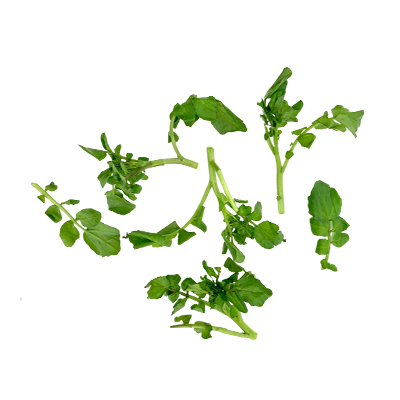Watercress
Nasturtium officinale W.T.Aiton
Brassicaceae
Location in our garden
Vegetable



Synonym
Arabis nasturtium Clairv.
Baeumerta nasturtium G.Gaertn., B.Mey. & Scherb.
Cardamine aquatica (Garsault) Nieuwl.
Habitus
Aquatic. Succulent, aquatic, perennial plant, can be 50 cm or longer.
Part Used
The Whole Plant
Growing Requirements
Full Sunshine
Need Shade
Habitat
Aquatic
Wetland
Overview
Native to Europe and western Asia, and possibly also in the highland regions of Ethiopia. The plant is a fairly well-known salad crop, often gathered from the wild but also grown commercially and sold in markets. It is also seen as a very healthy, vitamin and mineral rich food and, as such, has gained a reputation for its medicinal uses.
Vernacular Names
Phak kaat naam (Thailand), Xa lack xoong (Vietnamese), Dou ban cai (Chinese), Mizu garashi (Japanese), Mul naeng ee (Korean), Crescione acquatico (Italian), Cresson d'eau (French), Berros/mastuerzo (Spanish).
Agroecology
Watercress is a plant of the temperate zone, but it can be cultivated in the tropics at elevations between 1,000-3,000 m. It grows best in areas where annual daytime temperatures are within the range 12-17 °C. It prefers to grow in water about 5 cm deep with an optimum pH 7.2.
Morphology
- Stems - hollow, juicy, much-branched, with roots on stem nodes, up to 64.2 cm long.
- Leaves - alternate, stalked, pinnate, lateral leaflets in 2–9 pairs, sessile, nearly circular to elliptical or obovate, entire to slightly toothed, terminal leaflet usually larger, 2.3-3.8 cm long and 2.2-3.8 cm wide.
- Flowers - bisexual, petals obovate, white, free, with yellow anthers; ovary superior, 2- celled, style simple.
- Fruits - broadly linear silique 1–2 cm × 2–3 mm, with many seeds in 2 rows in each cell.
- Seeds - spherical, dark red-brown, reticulate, hypocotyl 7–8 mm long, epicotyl 2–3 mm long; cotyledons stalked, circular, 2–4 mm long, leafy.
Cultivation
- By seeds - sow in a pot emersed to half its depth in water. Germination should take place within a couple of weeks.
- By cuttings - virtually any part of the plant, including a single leaf, will form roots if detached from the parent plant.
Chemical Constituents
Watercress contained alkaloids, steroids/triterpenoids, monoterpenoids, phenols/polyphenols, flavonoids, tannins, saponin, quinone, hydroquinone, carbohydrates. and free amino acids.
Traditional Medicinal Uses
- The leaves are antiscorbutic, depurative, diuretic, expectorant, purgative, hypoglycaemic, odontalgic, stimulant and stomachic.
- The plant has been used as a specific in the treatment of tuberculosis.
- Studies have suggested cardioprotective, hypolipidemic, antioxidant, hepatoprotective, platelet aggregating, antitubercular, antigenotoxic, nephroprotective, antibacterial, anti-inflammatory, anticancer, wound healing, neuroprotective, antidiabetic properties.
- A poultice of the leaves is said to be an effective treatment for healing glandular tumors or lymphatic swellings.
- Applied externally, it has a long-standing reputation as an effective hair tonic, helping to promote the growth of thick hair.
- The freshly pressed juice has been used internally and externally in the treatment of chest and kidney complaints, chronic irritations and inflammations of the skin, etc.
Part Used
Reference Sources
- Menon, S. and Satria, A.(2017). Mengkaji aktivitas antibakteri Nasturtium officinale dan ekstrak etanol Pilea melastomoides terhadap Escherichia coli. Farmaka 15(1): 63-69.
- Rahman, D.R., Rimbawan, Madanijah, S., and Purwaningsih, S. (2017). Potensi selada air (Nasturtium Officinale R. Br) sebagai antioksidan dan agen antiproliferasi terhadap sel MCF-7 secara in vitro. J. Gizi Pangan 12(3): 217-224.
- Sa’adah, L. (2018). Karakterisasi morfologi selada air (Nasturtium sp.) di Kabupaten Batang. Al-Hayat: J. of Biol. and Appl. Biol. 1(2): 66-73.
- Salamah, E., Purwaningsih, S., and Permatasari, E. (2011). Aktivitas antioksidan dan komponen bioaktif pada selada air (Nasturtium officinale L.R.Br.). J. Pengolahan Hasil Perikanan Indonesia XIV(2): 85-91.

